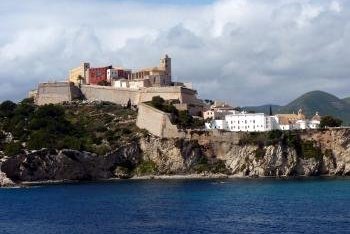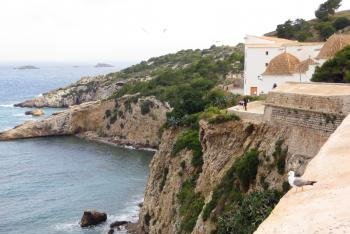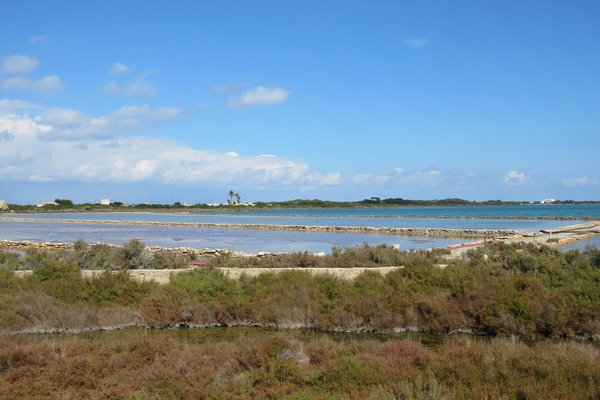Spain
Ibiza
Ibiza, Biodiversity and Culture, is renowned for its marine ecosystems, Phoenician ruins and fortified acropolis.
The marine ecosystem along the shoreline of the islands of Ibiza and Formentera is notable for its well-preserved Posidonia, a kind of seagrass. Ibiza has its roots as a Phoenician harbour and the 16th-century fortifications of its Upper Town have influenced harbour towns in the Spanish New World.
Community Perspective: Puig des Molins is the most interesting of the Phoenician sites to visit, and the Ses Salines Nature Reserve on Formentera is worth taking the ferry for from the party island of Ibiza proper.
Site Info
Official Information
- Full Name
- Ibiza, Biodiversity and Culture (ID: 417)
- Country
- Spain
- Status
-
Inscribed 1999
Site history
History of Ibiza
- 1999: Revision
- Successor of D'alt Vila TWHS (1985)
- 1999: Advisory Body overruled
- ICOMOS and IUCN recommended “Referral” and “Deferral” respectively
- 1999: Inscribed
- Inscribed
- 1987: Rejected
- As D'alt Vila: Not enough historical evidence. Later - would reconsider in new evidence
- Type
- Mixed
- Criteria
- ii
- iii
- iv
- ix
- x
Links
- UNESCO
- whc.unesco.org
- Official
-
- ibiza.travel — Ibiza Travel
- Related
-
- en.balearsnatura.com — Salt marsh natural park Ses Salines d’Eivissa i Formentera
- tourism.eivissa.es — Puig des Molins Museum-Necropolis
All Links
UNESCO.org
- whc.unesco.org — whc.unesco.org/
Official Website
- ibiza.travel — Ibiza Travel
Related Resources
- en.balearsnatura.com — Salt marsh natural park Ses Salines d’Eivissa i Formentera
- tourism.eivissa.es — Puig des Molins Museum-Necropolis
News Article
- April 23, 2013 fishnewseu.com — Anchors destroying posidonia meadow in Ses Salines
- May 29, 2006 ibiza-spotlight.com — Ibiza's Monster Marine Plant
Community Information
- Community Category
- Natural landscape: Marine and Coastal
- Archaeological site: Phoenician
- Urban landscape: Colonial
Travel Information
Recent Connections
-
Underwater Archaeology
The site has more than ten underwater a… -
Built in the 6th century BC
The Phoenician Punic cemetery Puig de M… -
Built in the 16th century
"The intact 16th century fortifications…
Connections of Ibiza
- Individual People
-
-
Christopher Columbus
His place of birth, according to a (disputed) theory
-
- Geography
- Trivia
-
-
Scuba Dive Liveaboard
-
Nudist beaches
Formentera is renowned across Europe for many pristine white beaches and the fact that nude sunbathing is allowed on most of its beaches (wiki)
-
- History
-
-
Punic Empire
Puig des Molins and Sa Caleta are both described in the AB ev as "Phoenician-Punic" -
Phoenician world
Port founded by Phoenician settlers in 654 BC
-
- Ecology
-
-
Lagoons
On Espalmador, the largest islet, there is an enclosed inland lagoon. These lagoons have long been used commercially as salt pans. (UNEP-WCMC) -
Salt Flats
Salinas de Ibiza y Formentera -
Dunes
Salinas de Ibiza y Formentera -
Bird Migrations
The African-Eurasian Flyway -
Endemic Bird Species
Balearic warbler, endemic to the Balearic islands -
Sharks
blue sharks, makos -
Flamingos
At Ses Salines (Formentera): "Between August and October hundreds of Flamingo arrive to spend the winter on the island." -
Seagrass beds
"very well preserved prairies of oceanic Posidonia (seagrass)" (AB ev) -
Turtles and tortoises
spur-thighed tortoise -
Seals
Mediterranean monk seal
-
- Damaged
-
-
Destroyed during invasion
By Vandals, 5th century
-
- World Heritage Process
-
-
Extended from original TWHS
Originally only D'alt Vila. An extended nomination followed a rejection in 1987. -
Mixed and Serial
Ses Salines d’Eivissa I Formentera is the natural component, the other 3 are cultural -
Mixed sites inscribed on 5 or more criteria
Criteria: ii/iii/iv/ix/x. 5 - 3 Cultural, 2 Natural
-
- Religion and Belief
-
-
Dominican Order
Dominican monastery & church within the walls of Dalt Vila -
Cathedrals
Our lady of the Snows
-
- Human Activity
-
-
Salt
Ses Salines -
Piracy
See therealibiza.com
-
LGBTQ culture
the Platja des Cavallets is within the boundaries, it is a famous gay nudist beach
-
- Constructions
-
-
Hypogea
The underground tombs in the Puig des Molins necropolis are described as "Hypogea"See digital.csic.es
-
Acropolis
emerges like an acropolis standing on a headland facing the sea (AB ev) -
Walled cities
Alta Vila (old city) -
Necropolises
Puig des Molins
-
- WHS on Other Lists
-
-
Centres of Plant Diversity
EU9 Islas Baleares - "The coastal and terrestrial parts of the site boast several endemic plant species, including rare and vulnerable species." -
Biodiversity hotspot
Mediterranean Basin -
Located in a TCC Territory
Balearic Islands -
Ramsar Wetlands
Salinas de Ibiza y Formentera (1993) -
Natura 2000
Salinas de Ibiza y Formentera
-
- Timeline
-
-
Built in the 6th century BC
The Phoenician Punic cemetery Puig de Molins ("At the beginning of the 6th century BC, the ashes of the dead were placed in a natural grotto after cremation) and site Sa Caleta (abandoned around 590 BC) (AB ev) -
Built in the 16th century
"The intact 16th century fortifications of Ibiza" (AB ev)
-
- Science and Technology
-
-
Underwater Archaeology
The site has more than ten underwater archaeological sites of the Late Bronze Age which have revealed the extent of early trade in the western Mediterranean (UNEP-WCMC)
-
News
- fishnewseu.com 04/23/2013
- Anchors destroying posidonia meado…
- ibiza-spotlight.com 05/29/2006
- Ibiza's Monster Marine Plant
Recent Visitors
Visitors of Ibiza
- Alberto Rodriguez Gutierrez
- Alexander Lehmann
- alicemears
- Ana Lozano
- Angela Vandyck
- ArnaudFilloux
- Atila Ege
- Bill Maurmann
- Bin
- Bropyk
- CampbellME
- Carlo Medina
- CherylKla
- ChrisN
- Christian Wagner
- Christine
- Christoph
- Christravelblog
- Cobaltrage
- Corinne Vail
- Csaba Nováczky
- Daniel Chazad
- Daniel Gabi
- Danny L
- DimiFW
- Dimitar Krastev
- dmscanlan
- Dorejd
- Dwight Zehuan Xiao
- edstar500
- Els Slots
- Emili Xaus
- Evgenii
- fabi-ddorf
- Fan Yibo
- Farinelli
- fedemarch92
- Femke Roos
- finsbury_jo
- FK
- Fmaiolo@yahoo.com
- forest80
- Gary Arndt
- George Gdanski
- Gernot
- Glenn Nightingale
- Hammeel
- Harald T.
- Harry Mitsidis
- Hdhuntphotography
- Hughes1920
- Iain Jackson
- Ivan Rucek
- Jana and Matt
- janameerman
- janem
- Jasam
- Jay T
- Jeanne OGrady
- Jesse S 2010
- Joebobs
- Joel on the Road
- Jonas Kremer
- Jon Eshuijs
- Just_hatched
- KarenBMoore
- Karito Vies
- Klaus Freisinger
- Krijn
- La Concy
- Lara Adler
- Laurey
- Lazerway
- Linz
- Loic Pedras
- Luboang
- Luis Filipe Gaspar
- Maciej Gil
- Martin
- Martina Rúčková
- maryhattie
- Mikko
- Milan Jirasek
- Monica Tasciotti
- Msarmiento1979
- napalm
- Nihal Ege
- Nuria8
- Patrik
- Peter Lööv
- Petteri
- Philipp Leu
- Philipp Peterer
- Porcho
- Rahelka
- Randi Thomsen
- Reiseblog
- Roel Sterken
- Roger Ourset
- Roman Bruehwiler
- Rudegirl
- Sabrina Liebehentschel
- Sandmann15
- Sandra!
- scubarrie
- Solivagant
- Stanimir
- stephanvermeulen
- Svein Elias
- Szabolcs Mosonyi
- Tarquinio_Superbo
- Thomas Buechler
- Thorben
- TimPick
- tommasorossotti
- Tonisan
- tony0001
- triath
- Tsunami
- ValiaVeweth
- Vanessa Buechler
- Walter
- WILLIAM RICH
- Wojciech Fedoruk
- Xander Huang
- Xiong Wei
- zinar7
- Zoë Sheng
Community Reviews
Show full reviews
Ibiza, Biodiversity and Culture is one of the most eclectic WHS on the list. It includes seagrass beds, salt lakes, Phoenician ruins and 16th-century military fortifications. As far as I am aware, there is no common link between these features besides their geographical proximity. Previous visitors rated this WHS a meager 2.08 out of 5 stars on average, so my expectations were not high when I flew out to Ibiza for a weekend in late February. But at least I would enjoy 2 days in the sun while it was freezing severely at home.
Saturday I spent on Formentera, Ibiza’s small sister island that lies half an hour away by ferry. It is much more unspoiled and features 32 ‘green routes’ of hiking and bike paths. The northern tip of Formentera is also part of the core zone of this WHS. It is known for two things: the salt flats, where flamingos and other birds nestle in winter. And for the ecosystem of the Posidonia seagrass – possibly the most unknown part of the site’s OUV.
By following trails #1, #19 and #2 from the harbour of Formentera, I created a nice 14km hike through Parque Natural de Ses Salines. I was looking out mostly for the seagrass and was expecting to see long, flat strips of green leaves underwater near the shoreline. I had no luck until I entered the beach of Ses Illetes (‘the best beach in Europe’, and a nudist beach too!). It is renowned …
Keep reading 0 comments
Q - “So, where are you off to this time?”. A- (somewhat diffidently!) “Oh, just to Ibiza!”. Response - “Not your normal sort of destination?” And that was true - for over 50 years we had passed over the Balearics as not being “worth” bothering with! But now they contained 2 of our last 3 unvisited Spanish WHS so the time had come to grit our teeth and join the “hordes”. But our timing in late March 2016 meant that we were well out of season and the resort areas beyond Ibiza centre were ghost towns. However, this also meant that museums and buses were still on the winter timetable, whilst our selection from among the all-night discos was to be severely limited!
We decided to get to Ibiza by taking the ferry from Palma after a few days in Mallorca - a 4 hour trip which gave us a fine view of the old town from the sea as we entered Ibiza port (photo) As other reviews have commented, the inscribed site has 4 elements and we took in 3 of them, leaving out the Punic site of Sa Caleta as no buses ran there on Sunday and a view of a few low walls seen through a boundary fence didn’t seem worth getting a taxi or rent-a-car for. We did pay a visit to the northernmost part of the Salines area. That is situated just south of the airport (the …
Keep reading 0 comments
There are some who go to Ibiza for the parties, and there are some who go for the World Heritage Site; count me in the latter group. When I was looking for an easy day trip from Barcelona in spring 2013, I settled on Ibiza since it was only a short flight away. Over 2600 years ago Ibiza was settled by the Phoenicians, who named their new port after the Egyptian god Bes (fittingly the god of music and dance). The Phoenician settlements and the fortified Dalt Vila, or Upper Town, in Ibiza Town form the cultural backbone of this mixed heritage inscription. On my visit, I spent a good couple of hours walking around the Upper Town ramparts and learning about the city's Arab, Catalan, and Spanish heritage. Unfortunately the cathedral was closed, but the views of the town, harbor, and rocky coastline from the fortress walls were impressive. Ibiza's natural component of its mixed heritage inscription is for coastal marine life supported by underwater seagrass. While I didn't get to see this component up close, I was very impressed with Ibiza's natural beauty, particularly on the rocky north shore near the Port of Saint Miquel, which, although not part of the inscribed area, was extremely photogenic.
Logistics: Ibiza is accessible by boat or plane, and I found it relatively easy to travel around the island via the local bus system.
Keep reading 0 comments
Surprisingly for many people, the holiday and party island of Ibiza has a wide range of historic and natural attractions that were somewhat randomly put together in one WH site. The major sight is Alta Vila, the historic centre of Ibiza Town. It sits on a high hill similar to the Acropolis and offers great views over the sea and the island. It is surrounded by a well-preserved city wall, and features several historic buildings, including the cathedral. Unfortunately, the archaeological museum next to it has been closed for budget reasons since January 2010. A short walk away, the Punic site of Puig des Molins has been closed for similar reasons since October 2010, although you can see quite a bit through the fences. The small archaeological site of Sa Caleta, on the coast near the airport, is also included, but there is really not much to see (only a small enclosed area with a few walls and stones). The natural component is the Ses Salines Nature Reserve, which covers the southern part of Ibiza, the northern part of Formentera, and the small rocks and seas between them. Taking the ferry between the islands gives you a good overview, and I also visited the Ses Salines beach on the southern tip of Ibiza, which includes walkways through pine forests and paths along the salines. I'm not sure if I saw any of the famous Posidonia sea grass, although it is entirely possible (hard to tell from normal algae). I arrived …
Keep reading 0 comments
Eivissa town is very compact which made reaching the castle and cathedral atop D'Alt Vila easy despite the steep hill upon which it is situated. The necropolises and one remaining windmill of the Puig des Molins are similarly situated.
I took bus #11 out past the airport to visit the salt lakes of Ses Salines as well as the nearby sandy but shadeless beach.
Afterwards I took a #26 bus around the coast to Sa Caleta where I walked out to the cliff edge to visit the excavated Phoenecian village.
Keep reading 0 comments
